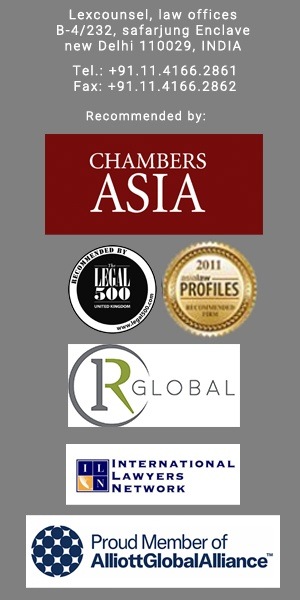
The Government of India has on January 10, 2012 relaxed the Foreign Direct Investment (“FDI”) policy to allow 100% FDI in single brand retail trading activities
If you have questions or would like additional information on the material covered herein, please contact:
A. Policy Revision: In terms of the press note issued in this regard, FDI of upto 100% is now permitted in single brand retail trading…

The Government of India has on January 10, 2012 relaxed the Foreign Direct Investment (“FDI”) policy to allow 100% FDI in single brand retail trading activities
A. Policy Revision:
In terms of the press note issued in this regard, FDI of upto 100% is now permitted in single brand retail trading activities. The policy now creates two categories of investment in single brand retail:
(i) FDI upto 51% (permitted since October 2006): All investments require prior Government approval, with conditions such as the products being branded during manufacturing, sold internationally under the same brand,
the investor being owner of the brand.
The current press note does not seek to change FDI conditions for upto 51% investment category.
(ii) FDI above 51% upto 100% (being permitted now): Henceforth, FDI upto 100% is allowed in single brand retail trading activities, subject to the conditions applicable to FDI upto 51% (stated above) and the following
additional conditions:
(a) At least 30% of the value of products sold would have to be mandatorily sourced from Indian small industries/village and cottage industries, artisans and craftsmen (collectively referred to herein as ‘Suppliers’).
(b) Compliance with the above condition is prescribed to be ensured through self-certification by the company, to be subsequently checked by statutory auditors from the duly certified accounts which the company will be
required to maintain.
‘Small industries’ are defined by the policy to mean industries which have a total investment in plant and machinery not exceeding USD 1 million at the time of installation, without providing for depreciation. If at any time, the valuation exceeds USD 1 million, the industry would cease to qualify as a ‘small industry’.
[Italics are ours, for ease of reference in our analysis below].
B. LexAnalysis:
The Government has indicated that it would continue to push for further relaxation in FDI regime, and the current policy revision appears to be another step in this direction. Unfortunately, the conservative approach of
‘taking one step at a time’ that the Government adopts concerning relaxation in retail trading regulations compels it to introduce qualifications and conditions not tried and tested earlier or elsewhere. This approach led
to introduction of requirements discussed under A(i) above while permitting single brand retail trading, which eventually discouraged many brand owners from investing under the route. Consequently, the average FDI
received in India under the said route during the last few years has reportedly been less than USD 10 million per year.
The new policy is also worded in a manner that would give rise to various concerns, considering that FDI in ‘Single Brand’ retail trading has been permitted keeping in view the luxury and premium goods segment. For
example:
(i) Protection and Answerability: Many brand owners have expressed their concerns over trustworthiness and seriousness of Suppliers in maintaining the quality and in protecting the intellectual property rights as well as
the technical knowhow that the brand owners would have to share while engaging them in manufacturing processes. Product pilferage, additional production for flea markets, timely delivery and quality control also remain
matters of concerns. Due to small nature of these Suppliers, the brand owners would also face difficulty in securing meaningful performance and other financial guarantees that could work as deterrent against non-performance and breach by them.
(ii) 30% Sourcing: The condition of sourcing 30% of value of products does not clarify whether the local sourcing can be used merely for supply of raw material or the local Suppliers should also participate in manufacturing process, or part of it. The reference to small industries/village and cottage industries, artisans and craftsmen seems to imply participation in manufacturing process. However, if it is interpreted to be manufacturing process necessarily, the policy may close the doors for many single brand owners as their products may not be such that they can be partially manufactured at different units and the cost of equipment per se can exceed USD 1 million for any single small industry unit manufacturing such products from start to finish. This is even assuming that the phrase ‘value
of products’ means cost of raw materials and other costs related to manufacturing of the product, and not the retail price of the end product.
(iii) Products Sold: It is unclear whether the 30% sourcing criterion needs to be met on an each product basis, or on a gross basis taking into account the value of the entire product range of any brand owner. For example, a
brand owner may have product lines including clothes, perfumes and accessories. Whether an overall compliance by sourcing 30% of the annual nventory value from Suppliers would suffice, or 30% of each product line also needs to adhere to the requirement, is unclear.
(iv) Definition of Small Industries: The definition of ‘small industries’ may hurt the very industries which perform well, as the definition itself restricts them from growing bigger without losing out on existing business from brand
owners. Any growth would also cause difficulties for brand owners in having to look for new and smaller suppliers, qualifying within the definition of ‘small industries’.
Furthermore, the criterion for being a small industry is specified in US$ terms. With foreign exchange fluctuations, many industries having investment in plant and machinery close to US$ 1 million may come in and go out of the definition of ‘small industries’ overnight, without any act or omission on their part. The brand owners could face regulatory repercussions of such an almost force majeure event.
(v) Artisans and Craftsmen: No definition or qualification criterion for artisans and craftsmen is provided by the policy. Technically, the brand owners making payments equivalent to 30% of the value of products to individuals, whom they consider to be artisans and craftsmen, would satisfy the 30% sourcing requirement of the policy. Absence of clear parameters can therefore result in failure of the policy in extending the intended benefits to the small industries, village and cottage industries.
(vi) Self certification: It is unclear whether the ‘self certification’ is required by the Suppliers or by the brand owners. The use of the word ‘company’ tends to suggest that the requirement of self certification is prescribed for
the brand owners. This compliance is sufficient to give palpitations to a number of brand owners as they may not know or be informed of plant and machinery enhancements by their small industry Suppliers, yet they may face related repercussions.
(vii) Frequency of Internal Compliance Assessments: The policy requires constant diligence by the brand owners to ensure compliance with 30% sourcing requirement, and impliedly that their small industry Suppliers are
in fact ‘small industries’ as per the definition. The requirement for self certification and verification by statutory auditor appears to suggest an annual exercise. However, the policy stipulation “if at any point of time, this valuation is exceeded, the industry shall not qualify as a small industry for this purpose” suggests ouster of any small industry from its definition anytime during the year. The change in status of any small industry in between two self certifications or verifications by statutory auditors could have retrospective repercussions for brand owners.
It is also unclear whether the requirement that 30% of the value of the products sold shall be sourced through Suppliers, should be met on a daily, weekly, monthly or on an annual basis. The policy could specify a minimum level of diligence by the brand owners to protect themselves against regulatory complications and administrative
actions, especially in events beyond their control. As a respite, the Government has assured that it may consider revisions to the policy to create a friendlier and conducive investment climate. One can expect significant discussion on the topic in the coming days.
Feedback
Disclaimer: LexCounsel provides this e-update on a complimentary basis solely for informational purposes. It is not intended to constitute, and should not be taken as, legal advice, or a communication intended to solicit or establish any attorney-client relationship between LexCounsel and the reader(s). LexCounsel shall not have any obligations or liabilities towards any acts or omission of any reader(s) consequent to any information contained in this e-newsletter. The readers are advised to consult competent professionals in their own judgment before acting on the basis of any information provided hereby.
